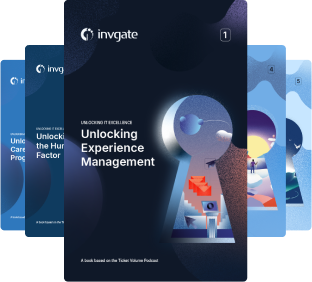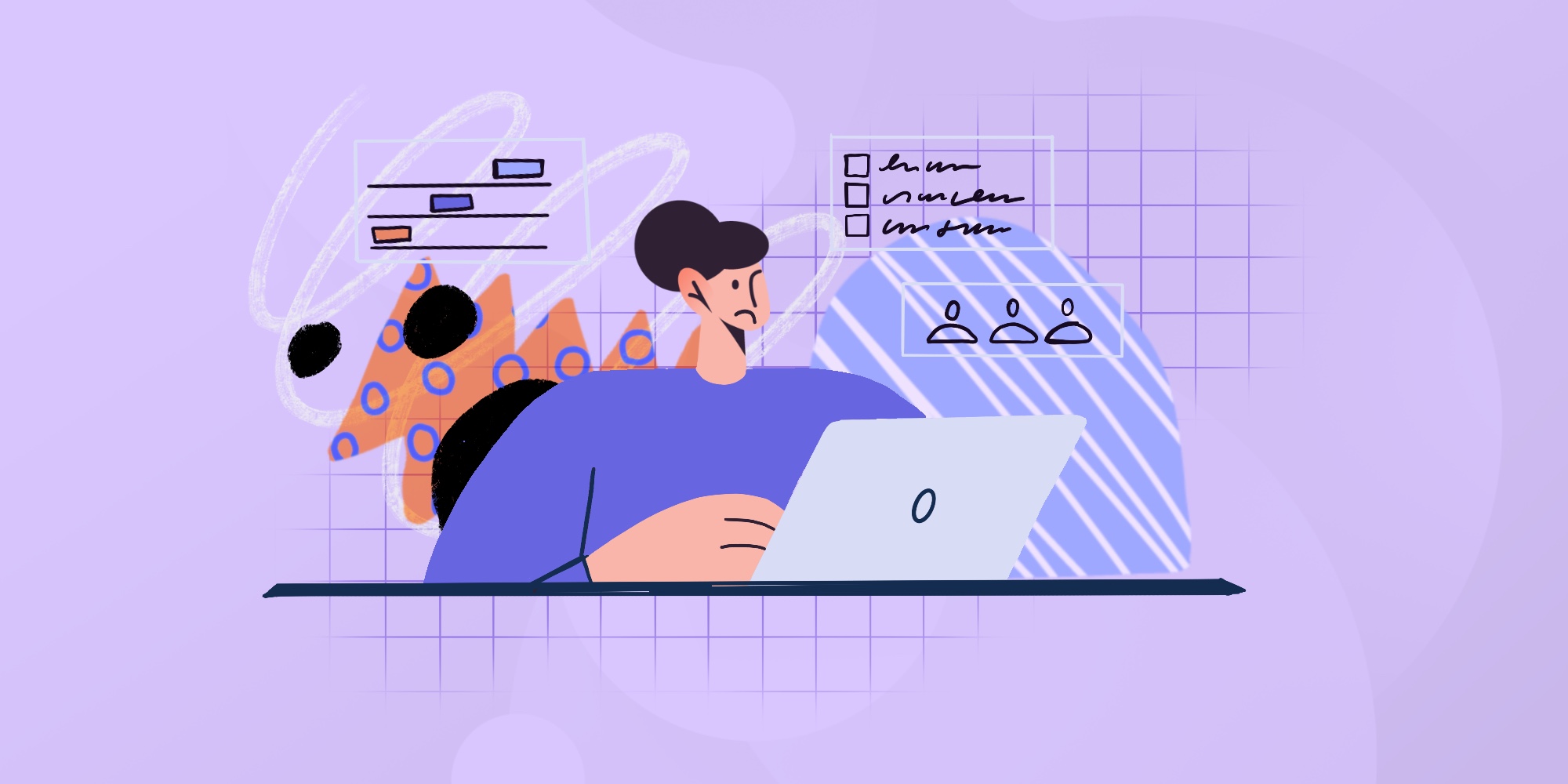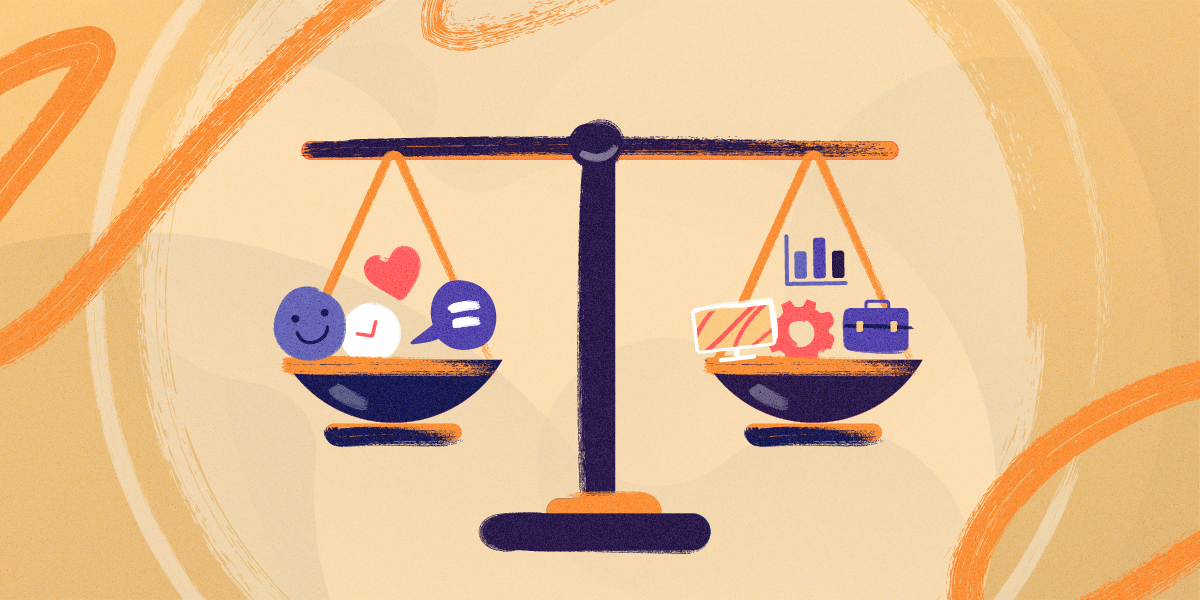Customer Service Management (CSM) is the backbone of creating enduring customer relationships and driving business growth. This article delves into the essence of CSM, unraveling professional tips and best practices that have been highlighted by industry leaders throughout the episodes of the Ticket Volume podcast.
These insights, now compiled in our first eBook Unlocking Experience Management (that you can download for free below!), serve as a guide for anyone looking to excel in Customer Service Management. Read on to discover actionable strategies that can transform your customer service operations and don't miss out on downloading our free eBook for a deeper exploration.
Let’s begin.
Table of contents
- Download First Ticket Volume Book
- What is Customer Service Management?
- Why is CSM important?
- 7 tips and best practices to do CSM
- 10 steps to build a Customer Service Management strategy
Download Unlocking Experience Management
Unlocking Experience Management
Discover how the experience you deliver can make or break your success.
Download for free
What is Customer Service Management?
Customer Service Management (CSM) represents a holistic strategy that aims not just to respond to customer needs but to anticipate them, ensuring every interaction with your brand is positive, seamless, and enriching.
This integrated approach goes beyond the traditional reactive model of addressing customer complaints and inquiries.
Instead, it involves a proactive engagement that seeks to elevate the customer's experience at every possible touchpoint, whether it be through direct communication channels like support calls and emails, social media interactions, or the indirect impact of product quality and marketing messages.
The scope of CSM
At its core, CSM is about recognizing that every facet of your business—from product development and marketing to sales and after-sales support—plays a critical role in shaping the customer's perception and, by extension, their loyalty and value to your brand.
For instance, it includes the initial touchpoints where potential customers interact with your marketing content, the sales process where they decide whether or not to purchase your product or service, and the after-sales support that helps resolve any issues they may face.
Activities under the CSM umbrella
Customer inquiries and issue resolution: This is the most direct interaction within CSM, where customer service representatives address the concerns and problems faced by customers. The goal here is not only to solve the issue at hand but to do so in a way that leaves the customer feeling valued and satisfied.
Proactive engagement: Unlike the traditional reactive approach, proactive engagement involves reaching out to customers before issues arise. This could be in the form of educational content that helps customers get more value from your product, satisfaction surveys that gather insights on their experience, or regular updates about new features and offers.
Experience enhancement: Every interaction with your brand, be it through product use, communication, or online presence, contributes to the customer's overall experience. CSM seeks to enhance this experience by ensuring consistency in message, quality in interaction, and reliability in product and service delivery. For example, using customer feedback to refine products, tailoring communication to individual customer needs, and ensuring your online platforms are user-friendly and informative.

Why is CSM important?
The importance of Customer Service Management can be attributed to a multifaceted impact on both the internal mechanisms of an organization and its external perceptions.
Here's a deeper look into why CSM is indispensable:
Enhances customer satisfaction and loyalty
CSM transcends the mere resolution of customer issues; it's about creating an emotional connection with customers by consistently meeting and exceeding their expectations. This approach acknowledges the customer's voice across every touchpoint, ensuring they feel heard, valued, and respected.
For instance, a customer experiencing a seamless resolution process during a service failure is more likely to remember the positive outcome than the issue itself, reinforcing their loyalty. Zappos, renowned for its customer service, leverages this aspect by empowering its customer service representatives to go above and beyond in ensuring customer satisfaction, even if it means directing a customer to a competitor.
Drives business growth through positive word-of-mouth
Satisfied customers are the most effective advocates for a brand. They are not only likely to return but also to bring new customers through positive word-of-mouth and social proof. This organic form of growth is invaluable, as recommendations from friends or family members carry more weight than traditional advertising.
An example of this is Apple, a company that has cultivated a loyal customer base through innovative products and exemplary customer service, encouraging customers to become brand evangelists who actively promote Apple products in their circles.
Improves operational efficiency by streamlining processes
A well-implemented CSM strategy can significantly enhance operational efficiency by identifying and eliminating redundant processes, automating routine tasks, and optimizing resource allocation. This lean approach to customer service not only reduces costs but also allows businesses to reallocate their savings towards innovation and growth.
For example, Amazon uses artificial intelligence (AI) and machine learning to anticipate customer inquiries and provide automated solutions, which streamlines the customer service process and frees up human agents to handle more complex issues.

Reduces customer churn and increases customer lifetime value
By consistently providing exceptional service, businesses can reduce the rate at which customers leave (customer churn) and increase the total revenue a customer generates over time (customer lifetime value, CLV). A focus on CSM helps in identifying the factors that lead to customer dissatisfaction and allows companies to address them proactively.
Adobe’s shift to a subscription-based model, coupled with its emphasis on customer service, illustrates how understanding and responding to customer needs can lead to reduced churn and increased CLV.
Fosters a culture of continuous improvement
CSM encourages a culture of feedback and continuous service improvement within organizations. Regularly gathering and analyzing customer feedback leads to insights that drive better product development, service enhancements, and customer service practices. This iterative process ensures that businesses remain aligned with customer expectations and industry standards.
Toyota’s philosophy of Kaizen, or continuous improvement, extends to its customer service, where feedback is used as a tool for constant enhancement of processes and customer interactions.
7 tips and best practices to do Customer Service Management
1. Embrace Experience Management as the core of ITSM
The integration of Experience Management into IT Service Management (ITSM) represents a paradigm shift towards a more user-centric approach in technology services. This transition acknowledges the importance of every interaction a user has with IT services, from the initial request to the final resolution.
Companies like Apple have set benchmarks in integrating user experience with ITSM, ensuring that their services are not only efficient but also intuitive and user-friendly.
Embracing this approach requires IT departments to work closely with user experience (UX) designers and customer service teams to create seamless, satisfying experiences that enhance productivity and user satisfaction.

2. Prioritize emotional intelligence and soft skills
In a digital world, human connections matter more than ever. Emotional intelligence and soft skills such as empathy, communication, and adaptability become the linchpins in delivering services that resonate on a personal level with users. Disney's customer service training program emphasizes these skills, teaching employees to create magical customer experiences through genuine, empathetic interactions.
Investing in soft skills training for IT and customer service teams can dramatically improve the quality of service interactions, turning routine transactions into memorable experiences that build loyalty and trust.
|
|
"Ultimately we need to refocus on the feeling, not on the numbers and not on the metrics." Doug Rabold |
3. Utilize Experience Level Agreements (XLAs)
Experience Level Agreements (XLAs) mark a significant evolution from traditional Service Level Agreements (SLAs), focusing on the quality rather than the quantity of service delivery. They measure success based on user satisfaction and emotional impact, offering a more comprehensive view of service effectiveness.

For instance, a company might use XLAs to gauge the emotional response of customers to a new online support portal, using feedback to fine-tune the portal's usability and content. Implementing XLAs involves developing new metrics and feedback mechanisms that capture the subtleties of user experience, challenging organizations to think creatively about how they measure success.
|
|
"XLAs... recognize that efficiency is just one part of a much broader, more nuanced picture of what quality service truly means." " Alan Nance |
4. Foster a culture of continuous feedback
A dynamic, responsive approach to Experience Management is built on a foundation of continuous feedback. This means not only soliciting feedback from users through surveys and direct communication but also creating channels for internal feedback among teams. Spotify's model of agile teams, or "squads," exemplifies this practice, with each squad focused on specific features and maintaining open lines of communication with users to iterate and improve quickly.
By embedding feedback mechanisms into every aspect of service delivery, organizations can remain agile, adapting to user needs and market changes with speed and precision.
|
|
"You have this continual presence, which is checking, everything's okay if something goes wrong, it's checking. It's fixing things, but it's also checking...is everything all right for you today?" Ian Aitchison |
5. Leverage advanced analytics and DEX tools
Advanced analytics and Digital Employee Experience (DEX) tools like Nexthink or Workspace ONE offer unprecedented insights into how users interact with IT services, identifying pain points and opportunities for proactive intervention. These tools can monitor system performance, user behavior, and satisfaction in real time, enabling IT teams to anticipate issues before they affect user productivity.
For example, predictive analytics might reveal that a particular application tends to slow down under certain conditions, allowing IT to optimize the application before it impacts user experience.
|
|
"A DEX tool will give you insight into a person's ability to do their job, which means information from their device...information about the sentiment of that individual." Ian Aitchison |
6. Adopt a holistic view of Experience Management
Adopting a holistic view of Experience Management means looking beyond individual transactions to understand the entire journey of a user or customer. This approach recognizes the interconnectedness of services and departments in shaping the user experience.
Amazon's cross-functional teams work collaboratively across departments to ensure a seamless customer journey from product discovery to purchase and support, exemplifying a holistic approach to Experience Management.
Organizations can achieve this by mapping out user journeys, identifying touchpoints, and aligning teams around shared objectives to enhance the overall experience.
7. Innovate in measuring experience
Innovation in measuring experience involves developing new metrics and using emerging technologies to capture and analyze user feedback. For example, sentiment analysis powered by AI can provide insights into the emotional tone of user feedback, while virtual reality (VR) simulations can offer a new dimension to user testing and feedback gathering.
By continuously exploring new ways to understand and quantify user experiences, organizations can gain deeper insights into what drives satisfaction and loyalty, enabling them to deliver services that truly resonate with users.
|
|
"The goal is not merely to get perfect scores on your Net Promoter System (NPS) but to make meaningful improvements in areas that matter most.." Pasi Nikkanen |
10 steps to build a Customer Service Management strategy
Here's a step-by-step guide to developing a CSM strategy that is actionable, effective, and tailored to meet your business and customer needs:
Step 1: Define your vision and objectives
Start by articulating a clear vision of what exceptional customer service looks like for your organization. Identify specific objectives you want to achieve with your CSM strategy, such as improving customer satisfaction scores, reducing response times, or increasing customer loyalty. This vision will guide your actions and help align your team's efforts.
Step 2: Understand your customers
Deeply understanding your customers is crucial. Utilize customer surveys, feedback, and data analytics to gather insights into their needs, preferences, pain points, and expectations. Creating customer personas can be a useful tool in this step, providing a detailed representation of your different customer segments.
Step 3: Map the customer journey
Identify all the touchpoints customers have with your brand, from initial awareness through to post-purchase support. Mapping the customer journey will help you understand the customer experience from their perspective, highlighting areas of excellence and opportunities for improvement.
Step 4: Assess your current capabilities
Evaluate your current customer service capabilities by reviewing your technology, processes, and team skills. Identify gaps between your current state and the desired customer service experience outlined in your vision. This assessment should include your digital tools, customer service policies, and the training and support provided to your customer service team.
Step 5: Invest in training and development
Recognizing that your team's soft skills are as important as their technical abilities, invest in regular training programs focused on emotional intelligence, communication, empathy, and problem-solving. Empowered and knowledgeable employees are the backbone of excellent customer service.

Step 6: Implement the right technology
Choose customer service technologies that support your objectives and enhance the customer experience. This may include CRM systems, live chat software, self-service portals, and advanced analytics tools. Ensure the technology integrates well with your existing systems and supports a seamless customer journey.

Step 7: Develop a feedback loop
Establish mechanisms for continuous customer feedback, such as surveys, social media monitoring, and direct communication channels. Internally, create a culture that values feedback and encourages employees to share insights and suggestions for improvement.
Step 8: Monitor performance and iterate
Use key performance indicators (KPIs) relevant to your CSM objectives to monitor performance over time. Regularly review these metrics to assess the effectiveness of your strategy and make necessary adjustments. Remember, CSM is an ongoing process that requires flexibility and a willingness to evolve based on customer needs and feedback.
Step 9: Celebrate successes and learn from failures
Recognize and celebrate the successes of your customer service team to motivate and encourage continued excellence. Equally, view failures or customer complaints as opportunities to learn and improve. Encourage a positive attitude towards continuous improvement across the organization.

Step 10: Align your organization around customer service
Ensure that customer service is not just the responsibility of one department but a core part of your organization's culture. Align your business operations, from product development to marketing and sales, around the goal of delivering exceptional customer service.
In short
To excel in Customer Service Management, you need to integrate several core principles into your strategy. This piece has navigated through the essentials of building an effective CSM strategy, underscoring the significance of understanding customer needs, leveraging technology, and fostering a culture centered around exceptional service.
By embedding these principles into your organization's DNA, you can achieve a CSM strategy that not only resolves customer issues but also builds loyalty, trust, and long-term relationships. Remember:
- Understand and prioritize the customer journey and experience.
- Equip your team with the skills and tools they need to succeed.
- Commit to agility and continuous improvement based on real-time feedback and data.
- Adhering to these guidelines will not only elevate your customer service management but also position your brand as a leader in customer satisfaction and loyalty.
For more helpful tips, we invite you to deepen your understanding of Customer Service Management by downloading our free eBook, Unlocking Experience Management This resource is packed with insights, best practices, and actionable strategies from industry leaders, designed to guide you through enhancing your customer service approach.
Whether you're just starting out or looking to refine your existing strategy, this free eBook serves as an invaluable tool for anyone committed to achieving excellence in customer service management. Download your copy today and take the first step towards transforming your customer service into a powerful engine for satisfaction and loyalty.















